Origin
The Mayan civilisation lasted from about 500 BC to 1200 AD, with a classical period from 300-900 AD. The earliest known writing in the Mayan script dates from about 250 BC, but the script is thought to have developed at an earlier date. Recent archeological finds indicate that the Mayan civilisation started much earlier: around 3,000 BC.In about 1566, the first bishop of Yucatan, Diego de Landa, compiled a key to the Mayan syllabary consisting of 27 Spanish letters and the Mayan glyphs with similar sounds. This became known as the Landa Alphabet and helped with the decipherment of the script, even though it was based on the false premise that the script was alphabetic.
For a long time many scholars believed that the script did not represent a language at all, or that it wasn't a complete writing system. The first major breakthrough in decipherment came during the 1950s when a Russian ethnologist, Yuri Valentinovich Knorosov, proposed that the Mayan script was at least partly phonetic and represented the Yucatec Mayan language. His ideas were not welcomed by other Mayanists, but he was eventually proved correct.
Further progress in the decipherment was made during the 1970s and 1980s when more linguistics began to take an interest in the script. Today most Mayan texts can be read, though there are still some unknown glyphs.
A gripping account of the decipherment of the Mayan script can be found in Breaking the Maya Code, by Micheal D. Coe.
The Yucatec Maya continued to use the Mayan script until at least the 16th century. Recently, their descendants have started to learn the script once again from the scholars who have deciphered it.
Notable features
- The Mayan script is logosyllabic combining about 550 logograms (which represent whole words) and 150 syllabograms (which represent syllables). There were also about 100 glyphs representing place names and the names of gods. About 300 glyphs were commonly used.
- Examples of the script have been found carved in stone and written on bark, wood, jade, ceramics, and a few manuscripts in Mexico, Guatemala and northern Belize.
- Many syllables can be represented by more than one glyph
- The script was usually written in paired vertical columns reading from left to right and top to bottom in a zigzag pattern.
The Mayan syllabary
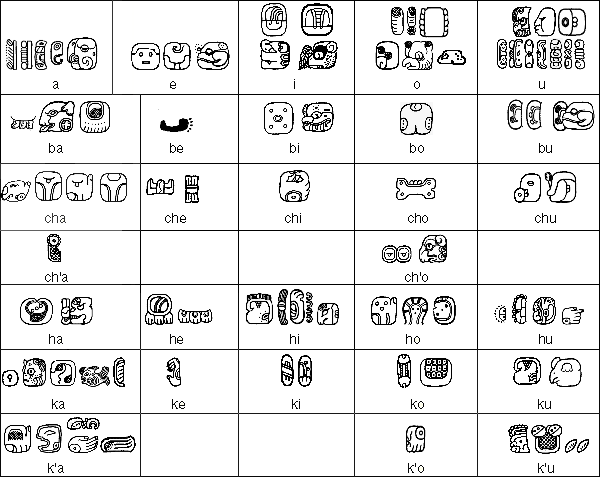
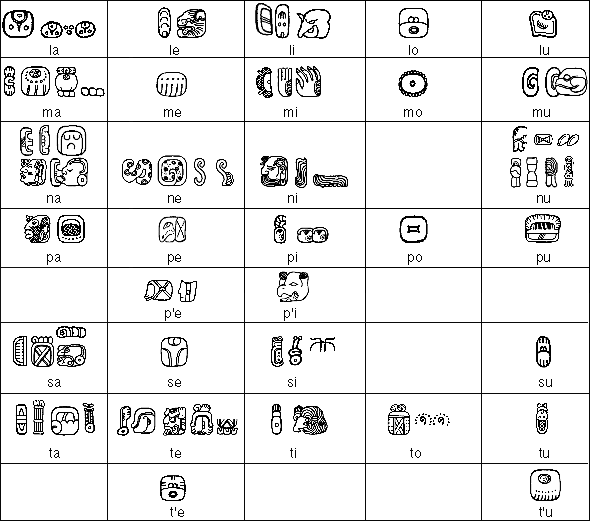
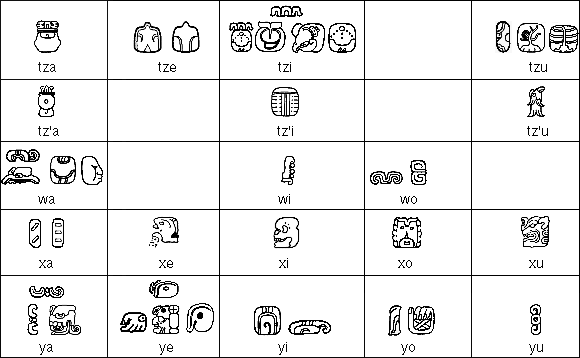
Numerals

Sample texts in some of the modern Mayan languages
-Huasteco (Teenek)
Patal an inik ani an uxum u wa'tsinal walkadh abal jununúl kin bats'uw an alwa'taláb ani ka pidhan in éy jant'ini' in tomnál; in kwa'al in tsalpádh ani in k'ayá' abal kin k'anidha' in juntal.Huasteco (Teenek)
Huasteco is a Mayan language with about 150,000 speakers in Mexico, mainly in the states of San Luis Potosi, Veracruz and Tamaulipas. Huasteco is also known as Huastec or Wastek, and the native name is Teenek or Tének.The three main varieties of Husteco are Northwestern Huastec (Huasteco de San Luis Potosi), which is spoken in parts of San Luis Potosi and northern Veracruz; Central Huastec (Huasteco de Veracruz), and Southeastern Huastec (Huasteco de San Francisco Chontla). Some linguists consider these dialects of one language, while other classify them as separate languages.
Huasteco pronunciation
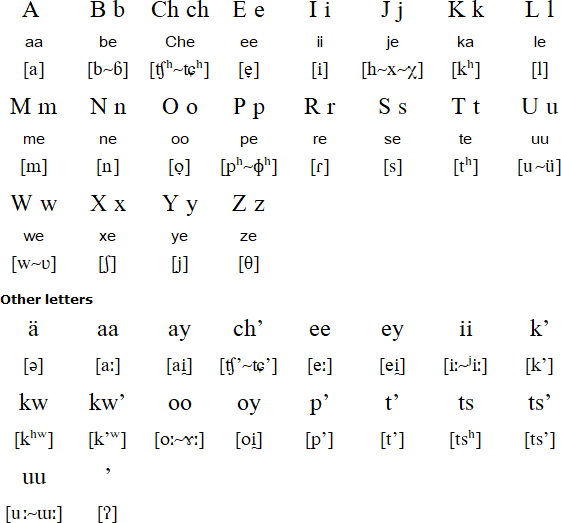
There are a number of other spelling systems for Huasteco. In some, for example, the /θ/ sound is written with a d or dh, as in the text below.
Sample text
Patal an inik ani an uxum u wa'tsinal walkadh abal jununúl kin bats'uw an alwa'taláb ani ka pidhan in éy jant'ini' in tomnál; in kwa'al in tsalpádh ani in k'ayá' abal kin k'anidha' in juntal.Translation
All human beings are born free and equal in dignity and rights. They are endowed with reason and conscience and should act towards one another in a spirit of brotherhood.(Article 1 of the Universal Declaration of Human Rights)
Books about Mayan writing, history and culture
Mayan language courses, dictionaries and phrasebooks
Links
Information about Huasteco languagehttp://www.native-languages.org/huasteco.htm
http://en.wikipedia.org/wiki/Wastek_language
-Kaqchikel (Kaqchikel Ch'ab'äl)
Konojel ri winaqi' kan kalaxib'en pe ri kolotajïk, ri junan kiq'ij, ri junan kejqalen, junan kich'ojib'al pa kik'aslen, xa achi'el k'a ri kik'ojlen, ri kinojib'al kichajin xa tik'amun k'a chi nimaläj konojel xtikajo' ki'.Kaqchikel (Kaqchikel Ch'ab'äl)
Kaqchikel or Kaqchiquel is a Mayan language spoken in the Central Highlands of Guatemala by about half a million people. It is a member of the Quichean-Mamean branch of Mayan languages and is closely related to K'iche' (Quiché) and Tz'utujil. The name of the language used to be written Cakchiquel or Cakchiquiel.An orthography for Kaqchikel was developed by the Academia de Lenguas Mayas de Guatemala (Guatemalan Academy of Mayan Languages).
Kaqchikel pronunciation
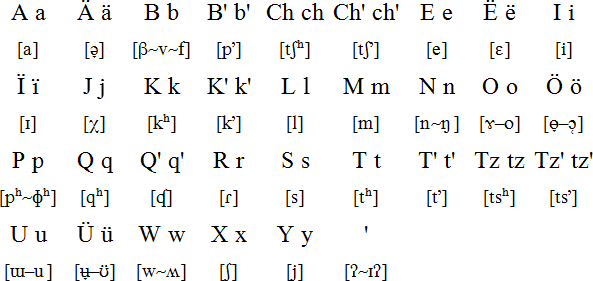
Sample text
Konojel ri winaqi' kan kalaxib'en pe ri kolotajïk, ri junan kiq'ij, ri junan kejqalen, junan kich'ojib'al pa kik'aslen, xa achi'el k'a ri kik'ojlen, ri kinojib'al kichajin xa tik'amun k'a chi nimaläj konojel xtikajo' ki'.Translation
All human beings are born free and equal in dignity and rights. They are endowed with reason and conscience and should act towards one another in a spirit of brotherhood.(Article 1 of the Universal Declaration of Human Rights)
Books about Mayan writing, history and culture
Mayan language courses, dictionaries and phrasebooks
Links
Information about Kaqchikel languagehttp://en.wikipedia.org/wiki/Kaqchikel_language
http://www.native-languages.org/kaqchikel.htm
http://www.archive.org/details/rosettaproject_cak_morsyn-1
-Mam (Qyol Mam)
Kyaqiilqe winaq nchi itz'aj tuj kopib'il, juunx kychuwiinqal b'ix kyokleen, kyja'tzan tuj tb'aanal xiinv'il tu'n kyanq'iin tuj b'ank'u'j kyxool.Mam (Qyol Mam)
Mam is a Mayan language spoken by about half a million people in Guatemala, mainly in the departments of Quetzaltenango, Huehuetenango and San Marcos, and in the Mexican state of Chiapas.There are three main varieties of Mam: Northern Mam, which is spoken in Huehuetenango; Southern Mam, which is spoken in Quetzaltenango, and Central Mam, which is spoken in San Marcos. Each of these has many sub-dialects and there is considerable variation in the language from village to village, however Mam speakers are able to understand one another reasonably well.
Mam pronunciation
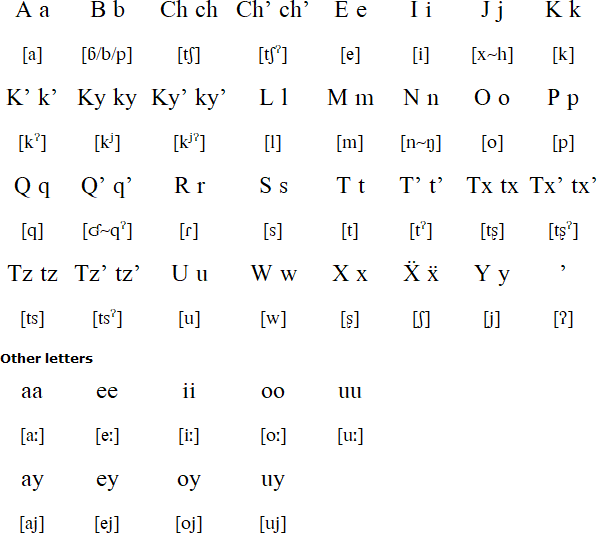
Sample text
Kyaqiilqe winaq nchi itz'aj tuj kopib'il, juunx kychuwiinqal b'ix kyokleen, kyja'tzan tuj tb'aanal xiinv'il tu'n kyanq'iin tuj b'ank'u'j kyxool.Translation (of all the above texts)
All human beings are born free and equal in dignity and rights. They are endowed with reason and conscience and should act towards one another in a spirit of brotherhood.(Article 1 of the Universal Declaration of Human Rights)
Useful phrases in Mam
Books about Mayan writing, history and culture
Mayan language courses, dictionaries and phrasebooks
Links
Information about Mam languagehttp://www.native-languages.org/mam.htm
http://en.wikipedia.org/wiki/Mam_language
http://www2.stetson.edu/~rsitler/TodosSantos/
Mam-English dictionary (PDF)
http://www.lrc.salemstate.edu/mam/mamdictionary.pdf
Diccionario del Mam-Español
http://www.cscd.osaka-u.ac.jp/user/rosaldo/Mam_Esp_DICC_COM.html
-Q'echi'
Chijunil li poyanam juntaq'eet wankil xloq'al naq nake'yo'la, ut kama' ak reheb' naq wan xna'leb'eb ut nake'reek'a rib', tento naq te'xk'am rib' sa' usilal chirib'ilrib'eb'.Q'eqchi'
Q'eqchi' or Kekchi is a Mayan language spoken by about 500,000 people in Guatemala and Belize. Q'eqchi' speakers are found mainly in the departments of Alta Verapaz, Petén, Izabal, Baja Verapaz, and El Quiché of Guatemala, and in the Toledo district of Belize.A number of orthographies have been developed for Q'eqchi', two of which are widely used: one was developed in the 1950s and 1960s by researchers from the Summer Institute of Linguistics (SIL), particularly Guillermo Sedat, Francis Eachus and Ruth Carlson. This orthography was used to produce a Q'eqchi' version of the Bible and a number of other texts and remains popular even though it is no longer considered standard. A newer orthography developed in 1980s and 1990s by the Proyecto Lingüistico Francisco Marroquin has become the standard written form of Q'eqchi' in Guatemala.
Literature in Q'eqchi' includes educational texts, religious texts, and a few collections of folk tales and other stories, as well as some government documents.
Q'eqchi' pronunciation
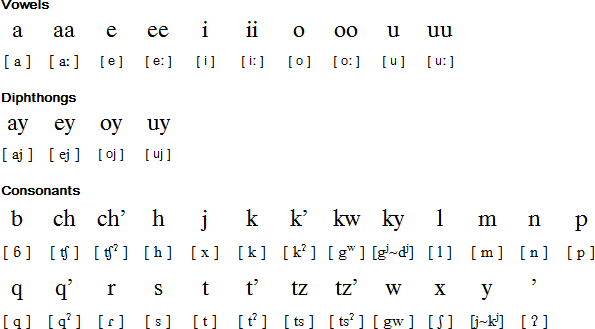
Sample text in Q'eqchi'
Chijunil li poyanam juntaq'eet wankil xloq'al naq nake'yo'la, ut kama' ak reheb' naq wan xna'leb'eb ut nake'reek'a rib', tento naq te'xk'am rib' sa' usilal chirib'ilrib'eb'.Translation
All human beings are born free and equal in dignity and rights. They are endowed with reason and conscience and should act towards one another in a spirit of brotherhood.(Article 1 of the Universal Declaration of Human Rights)
Tower of Babel in Q'eqchi'
Links
Information about Q'eqchi'http://www.native-languages.org/kekchi.htm
http://en.wikipedia.org/wiki/Q'eqchi'_language
Information about the Q'eqchi' people
http://www.nativeplanet.org/indigenous/maya/mayahistory.htm
The Mayan Languages - a database containing more than 40,000 entries for 31 Mayan languages: http://maya.hum.sdu.dk
-Tojol-a'b'al
Spetsanal ja swinkil ja lu'um k'inali junxta wax jul schonjel, sok ja sijpanub'ali, ja yuj ojni b'ob' sk'u'luk ja jas sk'ana-i ja b'as lekilali, ja yuj ja ay sk'ujoli sok ay spensari t'ilan oj yilsb'aje lek sok ja smoj jumasa.-Tsotsil (Bats'i k'op)
Skotol vinik o ants ta spejel balumile k´olem x-hayan i ko´ol ta sch´ulal i sderechoetik i, skotol k´ux-elan oyike oy srasonik y slekilalik, sventa skuxijik leknóo ta ju jun ju ju vo.Tsotsil (Bats'i k'op)
Tsotsil or Tzotzil is a Mayan language spoken in the Mexican state of Chiapas by about 330,000 people. It is closely related to Tzeltal and Ch'ol and is part of the Cholan-Tzeltalan branch of the Mayan language family.Tsotsil has six dialects which are named after the different regions of Chiapas in which they are spoken: Chamula, Zinacantán, San Andrés Larráinzar, Huixtán, Ch'enalho', and Venustiano Carranza. There is varying degrees of mutual intelligibility between them.
Tzotsil is used as a medium in instruction in some primary and secondary schools in central Chiaps
Tsotsil pronunciation
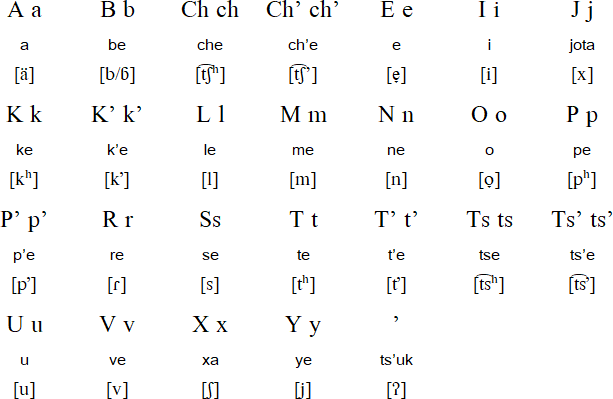
Note
w d f and g are used only in Spanish loanwords, and h is silent when not combined with c.Sample text
Skotol vinik o ants ta spejel balumile k´olem x-hayan i ko´ol ta sch´ulal i sderechoetik i, skotol k´ux-elan oyike oy srasonik y slekilalik, sventa skuxijik leknóo ta ju jun ju ju vo.Translation (of all the above texts)
All human beings are born free and equal in dignity and rights. They are endowed with reason and conscience and should act towards one another in a spirit of brotherhood.(Article 1 of the Universal Declaration of Human Rights)
Information about Tsotsil |
Tsotsil phrases |
Tower of Babel in Tsotsil |
Books about Mayan writing, history and culture |
Mayan language learning materials
Links
Information about Tsotsil/Tzotzil languagehttp://en.wikipedia.org/wiki/Tzotzil_language
An On-line Tzotzil Grammar (includes dialogues and recordings)
http://www.zapata.org/Tzotzil/
Survival phrases in Tzotzil
http://www.globalencounter.net/languages-tzotzil/
-Tzeltal (Batz'il K'op)
Spisil winiketik te ya xbejk´ajik ta k´inalil ay jrerechotik, mayuk mach´a chukul ya xbejka, ya jnatik stojol te jpisiltik ay snopibal sok sbijil joltik, ja´ me k´ux ya kaibatik ta jujun tul.-Yucatec Maya (Màaya t'àan)
Tuláakal wíinik ku síijil jáalk'ab yetel keet u tsiikul yetel Najmal Sijnalil, beytun xan na'ata'an sijnalil yetel no'oja'anil u tuukulo', k'a'abet u bisikuba bey láaktzilil yetel tuláakal u baatzile'.Yucatec Maya (Màaya t'àan)
Yucatec Maya is a Mayan language spoken by about 800,000 - 1.2 million people in Mexico and Belize. It is spoken mainly in Yucatan in Mexico, and there are also speakers in parts of Campeche, Tabasco, Chiapas, and Quintana Roo states in Mexico, and in northern Belize and Guatemala.A form of proto-Yucatecan was written with the Mayan script from about the 3rd century BC, and the Yucatec Maya speakers continued to use the script until the 16th century. Recently some Yucatecs have started learning and using the script once more.
After the Spanish conquest of Yucatan in the 16th century, a version of the Latin alphabet based on Spanish orthography of that time was developed to write Yucatec Maya. A new orthography, which is used in textbooks and offical documents, was developed by linguists of the Academia de Lenguas Mayas de Guatemala (ALMG) in 1984. A number of dictionaries in Yucatec Maya have been published, the first of which, by Juan Pio Perez, appeared in 1898.
A number of radio stations in Mexico broadcast programmes in Yucatec Maya.
Yucatec alphabet and pronunciation

Notes
- There are a number of different ways to represent Yucatec Maya with the Latin alphabet. This one comes mainly from native-languages.org
- Yucatec Maya has two tones: a high tone, sometimes represented with an acute accent (á), and a low tone, sometimes represented with a grave accent (à). Short vowels have a neutral tone, long vowels can have a high or low tone.
Sample text
Tuláakal wíinik ku síijil jáalk'ab yetel keet u tsiikul yetel Najmal Sijnalil, beytun xan na'ata'an sijnalil yetel no'oja'anil u tuukulo', k'a'abet u bisikuba bey láaktzilil yetel tuláakal u baatzile'.Translation
All human beings are born free and equal in dignity and rights. They are endowed with reason and conscience and should act towards one another in a spirit of brotherhood.(Article 1 of the Universal Declaration of Human Rights)
Information about Yucatec Maya |
Yucatec Maya phrases |
Tower of Babel in Yucatec Maya |
Books about Mayan writing, history and culture |
Mayan language learning materials
Links
Information about Yucatec Mayahttp://en.wikipedia.org/wiki/Yucatec_Maya_language
http://www.native-languages.org/maya_guide.htm
A Brief Introduction to Yucatec Maya
http://www.mostlymaya.com/yucatec_maya_intro_.htm
Yucatec Maya phrases
http://www.mostlymaya.com/yucatec_maya_intro_.htm
http://www.youtube.com/watch?v=tum7UWov0rI
http://en.wikipedia.org/wiki/Yucatec_Maya_language http://www.yucatanliving.com/culture/mayan-language-for-beginners-2.htm
A Basic English - Yucatec Mayan Dictionary
http://www.mostlymaya.com/EnglishMayan.html
Yucatán: Identidad y Cultura Maya
http://www.uady.mx/sitios/mayas/
Na'atik, Instituto de Lenguas y Culturas - courses in Spanish and Yucatec Maya in Carrillo Puerto, Quintana Roo, Mexico: http://www.naatikmexico.com
-Translation (of all the above texts)
All human beings are born free and equal in dignity and rights. They are endowed with reason and conscience and should act towards one another in a spirit of brotherhood.(Article 1 of the Universal Declaration of Human Rights)
Books about Mayan writing, history and culture
Mayan language courses, dictionaries and phrasebooks
Links
Information about the Mayan scripthttp://en.wikipedia.org/wiki/Maya_script
http://www.ancientscripts.com/maya.html
http://www.authenticmaya.com/maya_writing.htm
Dictionary of Maya Hieroglyphs
http://www.famsi.org/mayawriting/dictionary/montgomery/
The Mayan Epigraphic Database Project - includes a relational database of Mayan glyphs and an archive of digitally transcribed Mayan texts: http://jefferson.village.virginia.edu/med
Mayan fonts
http://www.dafont.com/font.php?file=mayan
http://babel.uoregon.edu/yamada/fonts/mayan.html
http://www.masterstech-home.com/
Foundation for the Advancement of Mesoamerican Studies
http://www.famsi.org
Mayan Civilization
http://www.crystalinks.com/mayan.html
The Mayan Languages - a database containing more than 40,000 entries for 31 Mayan languages: http://maya.hum.sdu.dk
A Brief Introduction to Yucatec Maya
http://www.mostlymaya.com/yucatec_maya_intro_.htm
A Basic English - Yucatec Mayan Dictionary
http://www.mostlymaya.com/EnglishMayan.html
Yucatán: Identidad y Cultura Maya
http://www.uady.mx/sitios/mayas/
Information about the Junp'iit Maaya (Yucatec Mayan) - includes prounciation some phrases with audio: http://www.unc.edu/depts/ilas/junpiitmaaya/expressions.htm
La Casa en el Arbol - language courses in Mayan (Tsotsil and Tseltal) and Spanish in San Cristobal de las Casas, Chiapas, Mexico
http://www.lacasaenelarbol.org/escuela-idiomas-mexico/cursos_idiomas.html
Na'atik, Instituto de Lenguas y Culturas - courses in Spanish and Yucatec Maya in Carrillo Puerto, Quintana Roo, Mexico: http://www.naatikmexico.com
Photos of and information about the Maya, Aztec and Inca peoples
http://mayaincaaztec.com
Maya jewelry
http://www.clearlight.com/bolaman/mayaglph.htm









.jpg)
.jpg)

.jpg)





0 comments:
Post a Comment
Note: Only a member of this blog may post a comment.